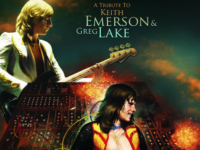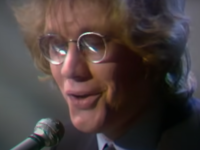Find out just how the Greg Kihn Band ended up with an outtake from Bruce Springsteen’s seminal recording Born to Run, and why the invention of the portable Casio keyboard sparked the group’s first-ever dance hit. Also, how one of Greg Kihn’s signature moments — those wordless interludes on “The Break Up Song” — happened quite by accident …
“ROADRUNNER,” (WITH THE NAKED EYE, 1979): A smart cover of a track by labelmates Jonathan Richman and the Modern Lovers, the original of which would eventually be ranked No. 269 on the Rolling Stone list of 500 greatest songs of all time. More interestingly, the song — with those rumbling cries of “radio on!” — presupposes what would become a second career for Kihn, who has since 1996 served as the morning drive-time DJ for classic-rock radio KFOX-98.5 FM in San Jose, California. It’s quite a change for a rocker with a legendary appetite for the nightlife.
GREG KIHN: I tell you, it wasn’t easy. It was like I moved to Australia. Suddenly, day is night and night is day. I used to go to bed a 4 in the morning, and now that’s when I get up. But, all of a sudden, I have been doing this for 15 years! I can’t believe it. I wouldn’t given it 15 days when I started. I still don’t know what I’m doing, and you never get used to getting up, but now that’s become part of my life. Frankly, I don’t know what I would do without it now.
“THE BREAK UP SONG,” (ROCKIHNROLL, 1981): A long-awaited breakthrough No. 15 hit for the Greg Kihn Band, and later featured in a number of films, “The Breakup Song” arrived seven albums into the group’s efforts at securing that elusive first hit. It’s best remembered for the seemingly off-the-cuff nah-uh-uh endings during each line of the verse. Turns out, they were actually, yes, off the cuff.
GREG KIHN: I didn’t do my homework. I didn’t have enough lyrics for the whole song. In the rehearsal, I was just singing “uh uhs,” and “nah nahs” and “la las.” Anything to take up space, figuring I would come back later and write in the lyrics. So I went in to do the vocals, and Matthew Kaufman — who produced it — was kind of sneaky. He would say: “Hey, man, this is just a work vocal. Don’t worry about it. We’re going to re-record it. Just lay one down so we know what we’ve got here.” So, you’d go out and kind of wing it — and then that would be the vocal that he’d use. So, literally, I was singing the nuh-uh-uh parts in the hopes that maybe the next day I would write lyrics. But I came back into the control room, after I finished the song, and everybody was just looking at me, like, “that was brilliant.” I was thinking: “What did I do?” (Laughs.) I thought they were going to be mad at me. I remember Steve Wright, the bassist in the band, putting his arm around me and saying: “That was rock ‘n’ roll.” The fact that you just go out there and wing it, that’s what made it so good. If I had gone back and written the lyrics into those lines, that would have just been another song.
“RENDEZVOUS,” (WITH THE NAKED EYE, 1979): A highlight of the newly released Greg Kihn Band: Best of Beserkley, 1974-1985, this was actually the Greg Kihn Band’s second take on a song from the notebooks of key influence Bruce Springsteen. But whereas “For You” had simply been a tribute to Springsteen, cribbed from 1973’s Greetings from Asbury Park, N.J., “Rendezvous” — a left over track from the ongoing Born to Run sessions — would come directly from the Boss himself.
GREG KIHN: We did Springsteen’s “For You” on the second album, and I remember we had worked it out in a rehearsal, and I wanted to do a kind of Byrds-type approach. I loved Bruce, and it was right after the The E Street Shuffle came out. People were starting to get turned on to Bruce, but he was not yet a superstar. To my knowledge, we were only the second group to do a Springsteen cover — after the Pointer Sisters, and “Fire.” Bruce heard it, and he loved the arrangement — and he started doing my ending and everything. So, he showed up one night when we were playing the Roxy about six months later. Lo and behold, he’s there — no entourage, alone, in a rented Corvette. He comes back stage, no bodyguards, and we’re all hugging and doing a couple of shots of tequila. He said he wanted to give me another tune, because he liked the way we had done “For You.” So, when the Boss gives me a song, I do it! (Laughs.) That’s when he gave us “Rendezvous.” He gave me the lyrics to the song, and a cassette. That cassette was an outtake from the Born to Run album, and “Rendezvous” didn’t make the cut. He was looking for a good home for the song. He said: “I was either going to give it to you, or to the Knack.” I said: “How come you gave it to us?” He said: “I thought you would last longer.” (Laughs.)
“MADISON AVENUE MAN,” (GREG KIHN AGAIN, 1977): A randy, Kinks-ish rocker powered by sharp indictments of fat cats calling the shots: “I can buy New York with my plastic card,” Kihn memorably huffed. Looking back, “Madison Avenue Man” neatly presupposed much of what a grizzled former indie-rock veteran like Kihn sees as the problem with music today: The process has become inverted, with label and TV executives deciding who makes it, whereas bands used to spend years building a groundswell of support through music making and live dates. Kihn says that’s why there are so many flash-in-the-pan acts these days.
GREG KIHN: The whole music industry has changed since I was back there putting out records. It’s a shame. I think what’s happening now, though, is that the pendulum is starting to swing back. Everything right now is corporate. Bands make it or don’t make it based on whether they are chosen in a boardroom somewhere, by winning a TV contest, anything but the regular way. The way we made it was, we played in bars for 20 years. You wrote songs every day, and kept putting out records locally until one day everything clicked. Nowadays, everything is the opposite: You begin with the fame, and hopefully the music will follow.
“JEOPARDY,” (KIHNSPIRACY, 1983): “Jeopardy” wasn’t just the Greg Kihn Band’s first and only Top 10 hit on the Billboard Hot 100 singles chart, having gone all the way to No. 2 in March of 1983 before getting turned back by Michael Jackson’s “Beat It.” The song was also became a charttopping smash on the dance charts a month later, perhaps the oddest achievement ever for a confirmed group of first-take garage rockers. Really, this one was not different — with the addition of a shiny piece of then-new electronics.
GREG KIHN: We hadn’t set out to have a dance hit. When I did that, I had no idea. Steve Wright, the bass player, had co-written most all of the songs in the Greg Kihn Band. He came over to my house one day, in like 1981. Casio had just come out with this little keyboard. It was about a foot long, it had a battery and it had a drum thing. It was a big deal. Steve had it, and he turned on the drum beat and he started riffing. The riff that he was playing was the “Jeopardy” riff. I swear to God, Nick, I didn’t even think about it. I just started singing: “Our love’s in jeopardy … baby.” It just came to me, out of the blue. That kind of backs up the theory that the great songs write themselves. That one certainly seemed to. Steve and I sat there in my living room, with that Casio — and, I kid you not, wrote that entire song in 15 minutes. Of course, in those days, spontaneity was what we brought to the party. We used to rehearse every single day, unless we had a gig. We would literally write a song a day. We were just fools for the music. I remember bringing that song, and me and Steve showing it to the rest of the band, and from that first day I knew: That’s a hit. I don’t know how to write a hit, but that was one. We went in and nailed in one or two takes. It’s like you channel the song, like a seance, and you just write it down.
- How Deep Cuts on ‘Music From Big Pink’ Underscore the Band’s Triumph - July 31, 2023
- How ‘Islands’ Signaled the Sad End of the Band’s Five-Man Edition - March 15, 2022
- The Band’s ‘Christmas Must Be Tonight’ Remains an Unjustly Overlooked Holiday Classic - December 25, 2016




